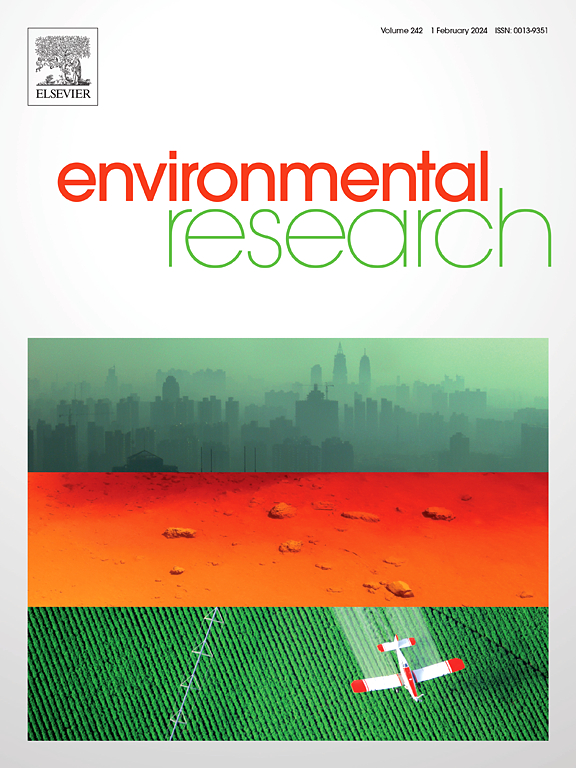py - bivo4 - cu2 +异质结的合成及其可见光催化降解2,4-二氯苯酚的研究
IF 7.7
2区 环境科学与生态学
Q1 ENVIRONMENTAL SCIENCES
引用次数: 0
摘要
2,4-二氯苯酚(2,4- dcp)是一种持久性有机污染物,长期暴露会对人类健康造成重大危害。光催化是一种高效、绿色的处理技术,在废水中有机污染物的降解方面具有很大的优势。本研究采用溶胶-凝胶法和化学氧化聚合法相结合的两步法合成了过渡金属铜离子(Cu2+)掺杂和导电聚吡咯(PPy)复合材料改性的py - bivo4 -Cu2+光催化剂。结果表明,原始BiVO4为单斜白钨矿相。Cu2+改性后,BiCu2VO6和CuO形成了新的晶相。并且发现Cu2+的改性和PPy的组合可以有效地提高光催化剂的电荷分离和迁移效率,实现230-800 nm的全光谱光吸收。降解实验结果表明,在可见光照射下,3% PPy-BiCu-4复合材料在1.5 h内对2,4- dcp的降解效率达到91.51%。机理研究表明,BiVO4、CuO和BiCu2VO6之间形成了双p-n异质结,并结合了PPy和BiVO4之间的z型异质结。在内建电场的驱动下,这些异质结构促进了电子-空穴对的有效分离和定向迁移。最终,PPy导带中的电子(e−)和CuO价带中的空穴(h+)生成了反应物质(•O2−和•OH),实现了2,4- dcp的高效降解。本研究阐明了PPy-BiVO4-Cu2+复合光催化剂内部的界面电荷转移途径,为光催化降解2,4- dcp废水提供了新的思路。本文章由计算机程序翻译,如有差异,请以英文原文为准。

Synthesis of PPy-BiVO4-Cu2+ heterojunction and its visible-light-driven photocatalytic degradation of 2,4-dichlorophenol
2,4-Dichlorophenol (2,4-DCP) as a persistent organic pollutant, poses significant health risks to humans through chronic exposure. Photocatalysis is an efficient and green treatment technology, which has great advantages in the degradation of organic pollutants in wastewater. In this study, the PPy-BiVO4-Cu2+ photocatalyst – modified with both transition metal copper ions (Cu2+) doping and conductive polypyrrole (PPy) composite – was synthesized via a two-step process combining sol-gel method and chemical oxidative polymerization method. The results show that the pristine BiVO4 is monoclinic scheelite phase. After Cu2+ modification, new crystalline phases of BiCu2VO6 and CuO were formed. And it is found that the modification of Cu2+ and the combination of PPy can effectively improve the charge separation and migration efficiency of the photocatalyst, and achieving full-spectrum light absorption across 230–800 nm. The degradation experimental results showed that the 3 %PPy-BiCu-4 composite material achieved 91.51 % degradation efficiency of 2,4-DCP in 1.5 h under visible light irradiation. Mechanistic studies demonstrated that the dual p-n heterojunctions formed among BiVO4, CuO, and BiCu2VO6, combined with the Z-scheme heterojunction between PPy and BiVO4. Driven by the built-in electric field, these heterostructures facilitated efficient separation and directional migration of electron-hole pairs. Ultimately, electrons (e−) in the conduction band of PPy and holes (h+) in the valence band of CuO generated reactive species (•O2− and •OH), achieving highly efficient degradation of 2,4-DCP. This study elucidates the interfacial charge transfer pathways within the PPy-BiVO4-Cu2+ composite photocatalyst, which provides a new idea for the photocatalytic degradation of 2,4-DCP wastewater.
求助全文
通过发布文献求助,成功后即可免费获取论文全文。
去求助
来源期刊

Environmental Research
环境科学-公共卫生、环境卫生与职业卫生
CiteScore
12.60
自引率
8.40%
发文量
2480
审稿时长
4.7 months
期刊介绍:
The Environmental Research journal presents a broad range of interdisciplinary research, focused on addressing worldwide environmental concerns and featuring innovative findings. Our publication strives to explore relevant anthropogenic issues across various environmental sectors, showcasing practical applications in real-life settings.
 求助内容:
求助内容: 应助结果提醒方式:
应助结果提醒方式:


